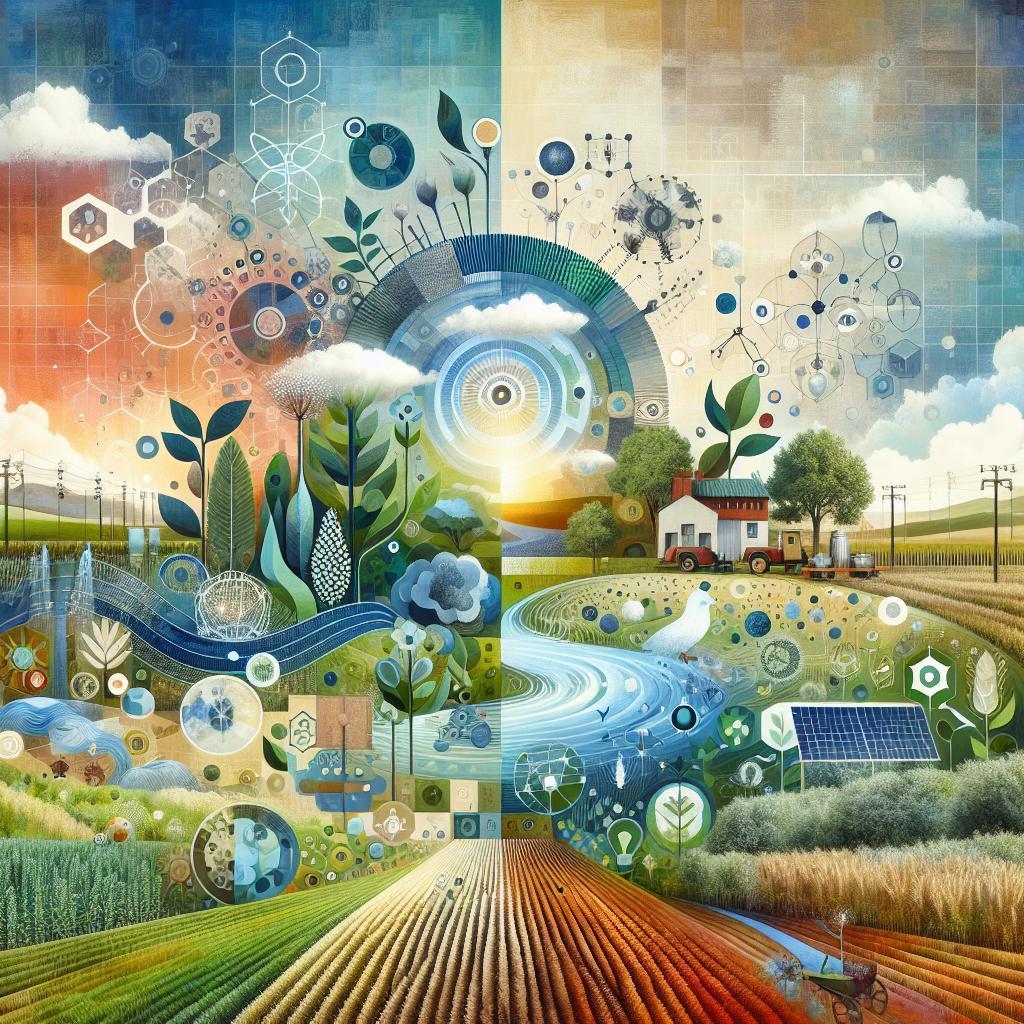This post may contain affiliate links which means I may receive a commission for purchases made through links. Learn more on my Private Policy page.
Introduction:
In a world where the hum of nature often plays second fiddle to the thrum of industry, the balance of our ecosystems hangs delicately in the balance. Agricultural landscapes, with their sprawling fields and endless rows of crops, have the potential to be vibrant habitats that support a rich tapestry of biodiversity. But how do we bridge the gap between cultivation – the relentless pursuit of food security – and the delicate symphony of life that flourishes in nature? Enter irrigation, a powerful ally in our quest to harmonize agriculture with the environment. Join us as we explore creative ways to harness irrigation not merely as a tool for crop production, but as a catalyst for fostering biodiversity, enriching our landscapes, and nurturing the planet we call home. With a sprinkle of ingenuity and a dash of care, we can cultivate not just food, but a thriving ecosystem that celebrates the intricate relationships between plants, animals, and the soil beneath our feet. Let’s dive in and discover how the right watering techniques can transform our agricultural fields into flourishing habitats that benefit us all!
Nurturing Nature: How Thoughtful Irrigation Practices Can Foster Diverse Habitats
By adopting careful irrigation strategies, farmers not only enhance their crop yields but also create a flourishing tapestry of life within their fields. Thoughtful irrigation increases moisture availability in the soil while minimizing water wastage, leading to healthier plant ecosystems. This, in turn, draws an array of creatures, from pollinators like bees and butterflies to birds and beneficial insects. Some effective practices include:
- Drip Irrigation: Targets the root zones of plants, reducing evaporation and runoff.
- Rainwater Harvesting: Collects and utilizes natural precipitation, replenishing habitats and cropping systems.
- Scheduling and Monitoring: Utilizes technology to manage water application times, ensuring both efficiency and habitat health.
Moreover, the establishment of wetland areas through regulated irrigation signifies a major leap towards biodiversity enrichment. These microhabitats serve as crucial refuges for endangered species and act as natural water filters. Creating zones in farm fields that mimic natural landscapes can significantly boost ecological resilience. To illustrate the potential of integrated irrigation systems, consider the following comparison:
| Irrigation Type | Benefits for Biodiversity |
|---|---|
| Traditional Flood Irrigation | Can cause erosion; may not support diverse habitats. |
| Drip Irrigation | Enhances soil moisture; attracts pollinators and beneficial insects. |
| Floodplain Restoration | Creates diverse wetland ecosystems, supporting varied wildlife. |

Watering Wisely: Techniques to Enhance Biodiversity in Farms
Effective irrigation practices do more than just nourish crops; they can serve as powerful tools for enhancing biodiversity on farms. By implementing techniques such as drip irrigation, rainwater harvesting, and timed irrigation systems, farmers can create a balanced environment that supports a diverse range of flora and fauna. For instance, drip irrigation delivers water directly to the plant roots, reducing water wastage and limiting the spread of diseases that can come from surface wetting. This precision not only conserves water but also fosters healthier ecosystems, allowing ground-nesting birds and beneficial insects to thrive alongside crops.
Another approach is the integration of buffer zones and wetlands into irrigation systems, which serve as critical habitats for wildlife while controlling water runoff. These zones can be populated with native plant species that are well adapted to local conditions and can support pollinators like bees and butterflies. To visualize the potential benefits of these irrigation techniques, consider the following table that highlights the ecological contributions of various practices:
| Irrigation Technique | Ecological Contribution |
|---|---|
| Drip Irrigation | Reduces disease spread, supports beneficial insects |
| Rainwater Harvesting | Provides clean water source for wildlife, conserves resources |
| Buffer Zones | Habitats for pollinators, reduces erosion |
| Constructed Wetlands | Water filtration, refuge for aquatic biodiversity |

Creating Corridors: Linking Aquatic Systems and Terrestrial Life through Strategic Irrigation
The integration of aquatic systems with terrestrial ecosystems can greatly enhance biodiversity in agricultural landscapes. By utilizing strategic irrigation techniques, farmers can create vital habitat corridors that connect wetlands, streams, and rivers to adjacent fields and forests. This fusion offers numerous benefits:
- Enhanced Wildlife Habitat: Providing shelter and food sources for various species, from insects to birds.
- Soil Health Improvement: Facilitating the movement of beneficial organisms that promote soil fertility.
- Flood Mitigation: Absorbing excess water during heavy rainfall, reducing soil erosion, and protecting crops.
Moreover, by implementing adaptive irrigation practices, farmers can maximize the use of water while minimizing waste. Techniques like drip irrigation or creating retention basins not only support sustainable agricultural practices but also ensure that water resources are available to support surrounding ecosystems. The following table illustrates some effective strategies related to water management:
| Strategy | Benefit |
|---|---|
| Drip Irrigation | Reduces water waste and directs moisture to root zones. |
| Retention Basins | Stores runoff water and recharges local aquifers. |
| Constructed Wetlands | Filters pollutants and provides habitat for wildlife. |

Tapping into Collaboration: Partnering with Local Ecosystems for Sustainable Farming Success
In recent years, an emphasis on local partnerships has proven to be a game-changer for sustainable agricultural practices. Collaborating with nearby farmers, community organizations, and environmental groups can foster a rich ecosystem supporting biodiversity. Sharing knowledge and resources allows for the development of effective irrigation techniques that not only conserve water but also enhance the resilience of local flora and fauna. By pooling together expertise, farmers can implement innovative practices such as:
- Crop rotation to improve soil health and reduce pests
- Rainwater harvesting to utilize natural resources
- Agroforestry to create diversified habitats
Engaging in these collaborative efforts is essential for creating a sustainable agricultural landscape, as it promotes a balanced relationship between farming and the environment. For example, local workshops can facilitate the exchange of best practices regarding irrigation systems designed to support diverse ecosystems. The incorporation of native plants into irrigation strategies can lead to increased pollinator populations, ultimately boosting crop yields. To further illustrate this collaboration, consider the following table that highlights successful partnerships and their ecological outcomes:
| Partnership | Practice Implemented | Ecological Benefit |
|---|---|---|
| Local Farm Co-op | Educational Workshops | Restoration of native pollinator habitats |
| Environmental NGO | Wetland Rejuvenation | Improved water filtration and habitat diversity |
| University Research Team | Data Sharing | Enhanced pest management strategies |
The Conclusion
As we wrap up our journey through the lush pathways of irrigation and biodiversity in agricultural landscapes, it’s clear that the connection between water management and wildlife stewardship is more profound than we might have imagined. Just as a careful gardener nurtures each plant, so too can farmers cultivate a vibrant ecosystem that is both productive and resilient.
Whether it’s through creating wetlands, strategically placing irrigation channels, or adopting practices that support pollinators and wildlife, each of us can play a role in harmonizing agriculture with nature. By embracing innovative irrigation strategies, we not only enhance crop yields but also foster an environment where flora and fauna thrive side by side with our food systems.
So, as we bid farewell to this exploration, let’s take inspiration from the rhythms of nature. Let’s unlock the potential of our fields not just for ourselves, but for all the creatures that call these landscapes home. After all, in the grand tapestry of life, every drop of water counts, and every effort to support biodiversity is a step towards a greener, more sustainable future. Happy farming! 🌿✨
This post may contain affiliate links which means I may receive a commission for purchases made through links. Learn more on my Private Policy page.

